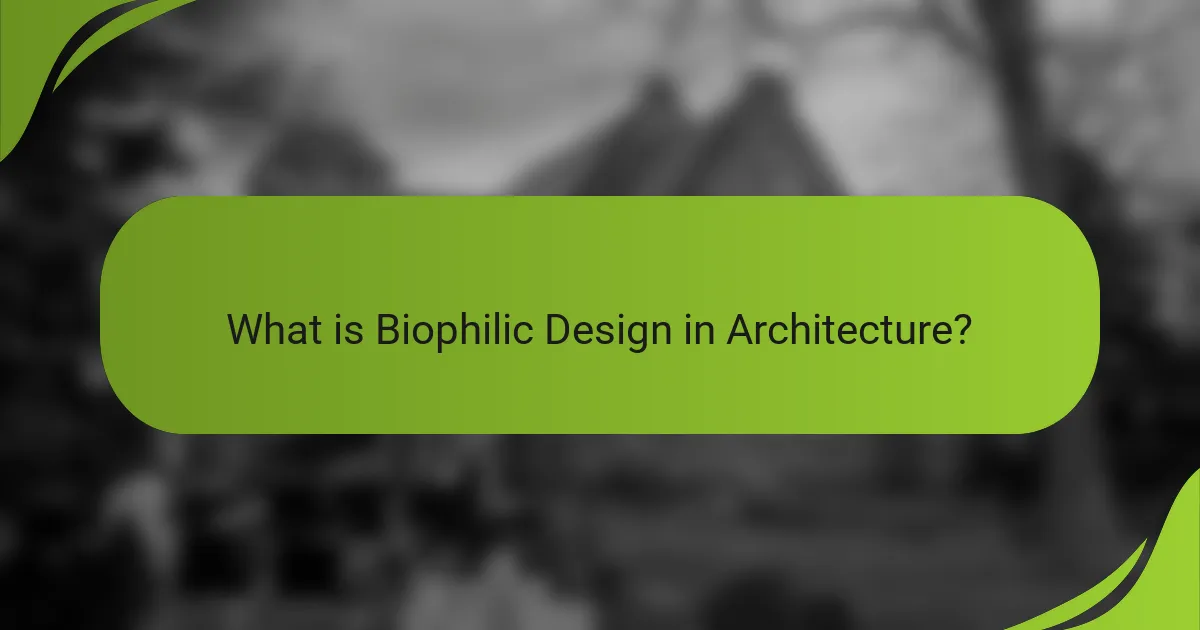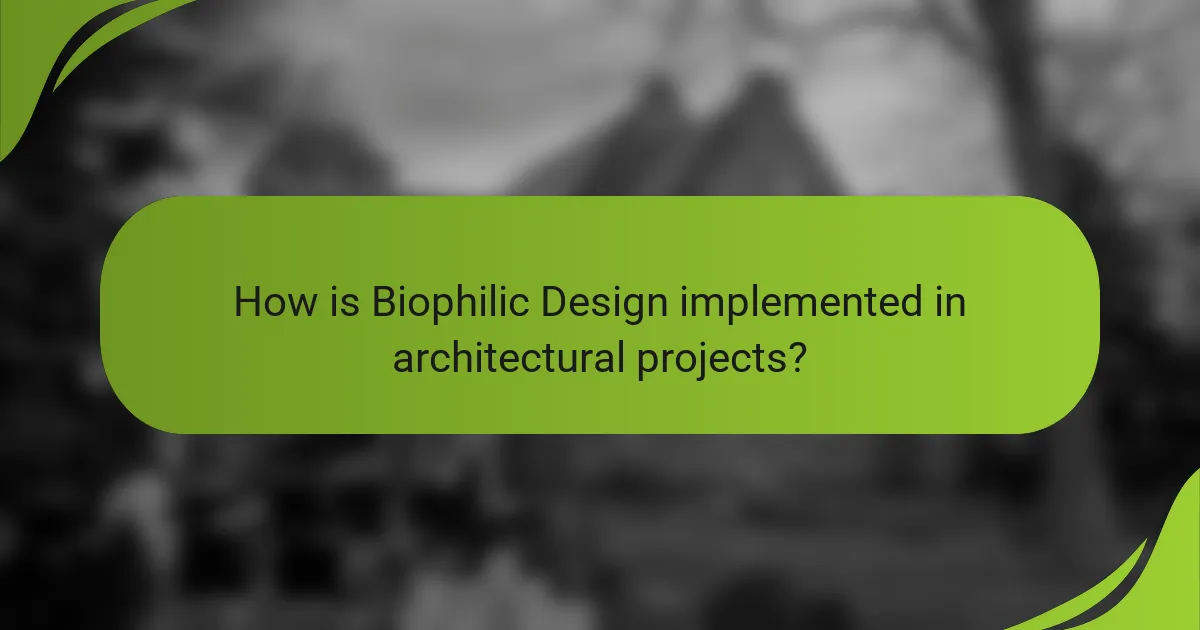Biophilic design in architecture integrates natural elements into built environments to foster a connection between people and nature, thereby enhancing well-being and productivity. This design philosophy emphasizes the incorporation of natural light, vegetation, and organic materials, which have been shown to reduce stress and improve mental health. Key features of biophilic design include large windows, green walls, and water features, all aimed at creating healthier and more inviting spaces. Future trends focus on increasing nature integration in urban settings, promoting sustainable materials, and leveraging technological advancements to optimize natural light and air quality, ultimately leading to greater occupant productivity and creativity.

What is Biophilic Design in Architecture?
Biophilic design in architecture is an approach that incorporates natural elements into built environments. This design philosophy aims to connect people with nature, enhancing well-being and productivity. It emphasizes the use of natural light, vegetation, and organic materials. Research shows that biophilic design can reduce stress and improve mental health. Studies indicate that spaces designed with biophilic principles can lead to increased creativity and focus. Examples include green walls, large windows, and water features. These elements create a more inviting and healthier atmosphere for occupants.
How does Biophilic Design influence human well-being?
Biophilic Design positively influences human well-being by integrating natural elements into built environments. This design approach enhances mental health by reducing stress and anxiety levels. Studies show that exposure to nature can improve mood and cognitive function. For instance, a research study published in the Journal of Environmental Psychology found that individuals in biophilic spaces reported higher levels of satisfaction and well-being. Additionally, natural light and greenery can increase productivity and creativity. The presence of plants in indoor spaces has been linked to lower blood pressure and improved air quality. Overall, Biophilic Design fosters a healthier and more enjoyable living experience.
What psychological effects does Biophilic Design have on occupants?
Biophilic Design positively affects occupants’ psychological well-being. It reduces stress and anxiety levels. Exposure to natural elements enhances mood and promotes relaxation. Studies show that incorporating greenery improves cognitive function. Natural light increases productivity and satisfaction. The presence of water features can evoke feelings of calmness. Biophilic Design fosters a connection to nature, leading to improved mental health. Research indicates that environments with biophilic elements are associated with higher levels of happiness and creativity.
How does exposure to nature in design enhance mental health?
Exposure to nature in design enhances mental health by reducing stress and improving mood. Natural elements in spaces can lead to lower cortisol levels. Studies show that individuals in environments with greenery report higher levels of well-being. A research study by Kaplan and Kaplan (1989) highlights the restorative effects of nature. Access to natural light and views of nature can also boost productivity. Furthermore, biophilic design can foster social connections, which are vital for mental health. Evidence suggests that nature exposure can reduce anxiety and depression symptoms. Overall, integrating nature into design creates healthier living and working environments.
What aesthetic principles are inherent in Biophilic Design?
Biophilic Design incorporates aesthetic principles that connect people with nature. These principles include the use of natural materials, organic shapes, and natural light. The design often features greenery and water elements to enhance visual appeal. Color palettes in Biophilic Design reflect natural landscapes. Textures used are reminiscent of natural forms, promoting tactile engagement. Open spaces and views of nature are prioritized to improve mental well-being. The incorporation of natural patterns can evoke a sense of calm. Evidence shows that environments designed with these principles can reduce stress and enhance creativity.
How do natural materials contribute to the aesthetic appeal?
Natural materials enhance aesthetic appeal through their organic textures and colors. Wood, stone, and plants create a sense of warmth and connection to nature. These materials often exhibit unique patterns and imperfections, adding character to spaces. Research shows that environments featuring natural materials can improve mood and reduce stress. A study by Kaplan and Kaplan (1989) highlights how natural elements promote feelings of tranquility. The visual diversity of natural materials can also create dynamic and engaging spaces. Overall, natural materials foster a harmonious atmosphere that resonates with human senses.
What role does natural light play in Biophilic Design aesthetics?
Natural light is essential in Biophilic Design aesthetics. It enhances visual appeal and connects occupants to nature. Natural light improves mood and productivity by reducing stress levels. Research shows that spaces with ample natural light can increase overall well-being. Studies indicate that exposure to daylight can enhance cognitive functions and creativity. Additionally, natural light creates dynamic environments through changing patterns and shadows. This variation adds depth and interest to interior spaces. Ultimately, integrating natural light is a key strategy in achieving Biophilic Design goals.
What functional benefits does Biophilic Design provide?
Biophilic Design provides functional benefits such as improved air quality and enhanced natural lighting. These elements contribute to a healthier indoor environment. Increased exposure to natural elements can reduce stress and improve overall well-being. Studies show that workplaces designed with biophilic principles can boost productivity by up to 15%. Incorporating plants can also lower indoor pollutants by 50%. Natural light helps regulate circadian rhythms, promoting better sleep and alertness. Overall, Biophilic Design enhances user satisfaction and fosters a connection to nature.
How does Biophilic Design improve indoor air quality?
Biophilic design improves indoor air quality by incorporating natural elements like plants and natural light. These elements enhance air purification through the process of photosynthesis. Plants absorb carbon dioxide and release oxygen, which increases overall air quality. Additionally, biophilic design often includes ventilation strategies that mimic natural airflow patterns. This promotes better circulation of fresh air indoors. Studies show that environments with biophilic features can reduce pollutants and allergens. For instance, a study published in the “Journal of Environmental Psychology” found that indoor plants can reduce airborne dust levels by up to 20%. Thus, biophilic design effectively contributes to healthier indoor air quality.
What impact does Biophilic Design have on energy efficiency?
Biophilic Design positively impacts energy efficiency by integrating natural elements into architectural spaces. This design approach enhances natural light usage, reducing reliance on artificial lighting. Increased ventilation from natural airflow can lower heating and cooling demands. Studies show that buildings designed with biophilic principles can achieve up to 30% energy savings. Incorporating plants can improve air quality, leading to healthier indoor environments. The connection to nature can also enhance occupant productivity and well-being, indirectly influencing energy consumption patterns. Overall, biophilic design promotes sustainable practices while improving energy efficiency in buildings.

How is Biophilic Design implemented in architectural projects?
Biophilic design is implemented in architectural projects through the integration of natural elements. This includes maximizing natural light, using organic materials, and incorporating greenery. Architects often design spaces with large windows to connect indoors with the outdoors. Living walls and indoor gardens are common features that enhance the presence of nature. Water features like fountains or ponds are also integrated to promote tranquility. Natural ventilation systems are employed to improve air quality and comfort. The layout of spaces is often designed to mimic natural forms and patterns. Research shows that such designs improve occupant well-being and productivity.
What are the key strategies for integrating Biophilic Design?
Key strategies for integrating Biophilic Design include maximizing natural light, incorporating plant life, and using natural materials. Maximizing natural light enhances mood and productivity. Studies show that exposure to natural light can improve overall well-being. Incorporating plant life creates a connection to nature. Research indicates that indoor plants can reduce stress and increase creativity. Using natural materials like wood and stone fosters a sense of warmth and comfort. These materials can improve air quality and aesthetic appeal. Additionally, creating views of nature can enhance occupants’ satisfaction. Evidence suggests that views of greenery can lower blood pressure and improve focus.
What types of natural elements can be incorporated into designs?
Natural elements that can be incorporated into designs include plants, water features, natural light, and organic materials. Plants such as trees, shrubs, and indoor greenery enhance air quality and aesthetics. Water features like fountains and ponds provide soothing sounds and visuals. Natural light, achieved through windows and skylights, boosts mood and productivity. Organic materials such as wood, stone, and bamboo create a connection to nature. These elements contribute to biophilic design, which promotes well-being and functionality in architectural spaces.
How can landscape features be integrated into architectural spaces?
Landscape features can be integrated into architectural spaces through various design strategies. These strategies include incorporating green roofs, which provide insulation and reduce urban heat. Vertical gardens can also enhance aesthetics and improve air quality. Water features, such as ponds or fountains, create a calming atmosphere and attract wildlife. Additionally, using native plants in landscaping promotes biodiversity and requires less maintenance. Pathways can be designed to weave through natural elements, encouraging interaction with the landscape. Outdoor spaces can be seamlessly connected to indoor areas through large windows and sliding doors, enhancing the sense of space. Studies show that integrating nature into architecture improves occupant well-being and productivity.
What challenges are faced when applying Biophilic Design?
Challenges faced when applying Biophilic Design include high implementation costs. Integrating natural elements often requires specialized materials and design expertise. Limited access to suitable sites can hinder the application of biophilic principles. Regulatory constraints may restrict design choices that enhance natural features. Additionally, inconsistent understanding of biophilic concepts among stakeholders can lead to misalignment in project goals. Maintenance of natural elements can also pose long-term challenges. Lastly, measuring the impact of biophilic design on well-being can be complex and subjective.
How can architects overcome limitations in urban environments?
Architects can overcome limitations in urban environments by integrating biophilic design principles. Biophilic design incorporates natural elements into urban architecture. This approach enhances well-being and functionality in densely populated areas. For example, incorporating green roofs and vertical gardens improves air quality and provides natural insulation. Studies show that access to nature reduces stress and increases productivity. Furthermore, architects can utilize adaptive reuse of existing structures to minimize environmental impact. This method preserves historical elements while meeting modern needs. By prioritizing sustainability, architects can create resilient urban spaces that foster community and enhance quality of life.
What are the cost considerations of incorporating Biophilic elements?
Incorporating biophilic elements involves several cost considerations. Initial investment can be higher due to specialized materials and design. Integrating natural elements may require skilled labor and precise planning. Long-term savings can arise from reduced energy costs and improved occupant health. Studies indicate that biophilic design can increase property value by up to 15%. Maintenance costs may vary depending on the type of plants or materials used. Overall, the financial implications depend on project scale and design complexity.

What are the future trends in Biophilic Design?
Future trends in biophilic design include increased integration of nature into urban environments. This trend focuses on creating green spaces within cities. It aims to enhance mental well-being and reduce stress. Another trend is the use of sustainable materials in construction. This promotes environmental responsibility and aesthetic appeal.
Technological advancements are also influencing biophilic design. Smart systems can optimize natural light and air quality in buildings. Additionally, the incorporation of living walls and green roofs is becoming more common. These features improve air quality and provide insulation.
Research shows that biophilic design can lead to higher productivity and creativity. A study by the University of Exeter found that productivity can increase by 15% in green office environments. These trends reflect a growing recognition of the importance of nature in our daily lives.
How is technology influencing Biophilic Design practices?
Technology is significantly influencing Biophilic Design practices by enhancing the integration of natural elements in built environments. Digital tools allow architects to simulate natural light and ventilation, improving indoor air quality. Smart sensors monitor environmental conditions, facilitating optimal plant placement and care. Virtual and augmented reality enable immersive experiences that connect occupants with nature. Advanced materials mimic natural textures and colors, fostering a sense of calm. Data analytics helps measure the impact of biophilic elements on well-being. Research indicates that environments incorporating technology-driven biophilic design can reduce stress and increase productivity. Overall, technology supports a more effective implementation of biophilic principles in architecture.
What role does virtual reality play in Biophilic Design exploration?
Virtual reality (VR) enhances Biophilic Design exploration by providing immersive experiences. It allows designers to simulate natural environments effectively. Users can interact with these environments in real-time. This interaction fosters a deeper understanding of spatial relationships and aesthetics. VR also aids in visualizing how natural elements can be integrated into built spaces. According to a study by Kahn et al. (2018), VR can increase emotional responses to nature. This emotional engagement can lead to improved well-being in architectural settings. Thus, VR serves as a powerful tool in the exploration and application of Biophilic Design principles.
How can smart building technologies enhance Biophilic elements?
Smart building technologies enhance biophilic elements by integrating natural features into built environments. These technologies facilitate the use of natural light, improving occupant well-being. For instance, automated shading systems adjust to sunlight levels, reducing glare while maximizing daylight. Smart HVAC systems can regulate indoor air quality, mimicking natural ventilation patterns. Additionally, IoT sensors can monitor plant health in indoor gardens, ensuring optimal growth conditions. Research shows that environments incorporating biophilic design can increase productivity by up to 15%. Smart technologies, therefore, not only support these designs but also enhance their effectiveness and sustainability.
What are some successful case studies of Biophilic Design?
Successful case studies of Biophilic Design include the Bosco Verticale in Milan, Italy. This residential complex features vertical gardens that enhance biodiversity. The design incorporates over 9,000 trees and 20,000 plants. This greenery improves air quality and provides residents with nature views. Another example is the One Central Park in Sydney, Australia. It includes rooftop gardens and green walls that promote well-being. The project integrates natural light and ventilation, enhancing the living experience. Additionally, the Amazon Spheres in Seattle, USA, feature a unique biophilic design. These glass domes house over 40,000 plants from various ecosystems. They create a serene environment for employees and visitors. Each case demonstrates the positive impact of incorporating nature into urban design.
What lessons can be learned from notable Biophilic architecture projects?
Notable biophilic architecture projects teach several key lessons. They demonstrate the importance of integrating nature into built environments. This integration enhances occupants’ well-being and productivity. Projects like the Eden Project in the UK show that natural light and greenery can improve mood. The Bosco Verticale in Milan illustrates how vertical gardens can reduce urban heat and improve air quality. Additionally, the One Central Park in Sydney highlights the value of outdoor spaces for social interaction. These examples reinforce that biophilic design can lead to sustainable and healthier urban living.
How do these projects demonstrate the benefits of Biophilic Design?
Biophilic Design enhances well-being by integrating natural elements into architecture. These projects often include features like natural light, vegetation, and water elements. Such design promotes mental health and reduces stress. Studies show that exposure to nature can improve mood and cognitive function. For instance, a study by Ulrich (1991) found that patients with views of nature required less pain medication. Additionally, incorporating greenery can improve air quality and biodiversity. Projects showcasing biophilic design often result in higher user satisfaction and productivity. This demonstrates the tangible benefits of connecting built environments with nature.
What are best practices for implementing Biophilic Design in your projects?
Incorporate natural elements into your projects to enhance biophilic design. Use plants, natural light, and water features to create a connection with nature. Design spaces that maximize views of the outdoors. Utilize natural materials like wood and stone for authenticity. Ensure good air quality through ventilation and greenery. Create diverse environments that offer various experiences. Promote sensory engagement with textures, sounds, and scents. Research shows that biophilic design can improve well-being and productivity by up to 15%.
Biophilic design in architecture is an approach that integrates natural elements into built environments to enhance occupant well-being, aesthetics, and functionality. This design philosophy emphasizes the use of natural light, vegetation, and organic materials, which have been shown to reduce stress, improve mental health, and boost productivity. The article explores the psychological effects of biophilic design, its aesthetic principles, functional benefits, and implementation strategies, along with future trends and successful case studies that highlight its positive impact on urban living. Key considerations, challenges, and best practices for incorporating biophilic elements into architectural projects are also discussed.